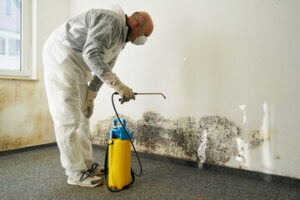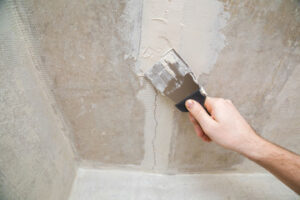Mold growth on walls isn’t just unsightly; it eats away at the building materials and can cause health problems for those who breathe in the spores. It’s important to act quickly to remove and kill mold when it first appears.

Mold remediation involves identifying and fixing the source of moisture in walls; removing and killing moldy drywall, insulation and other materials; cleaning and disinfecting the remaining walls. Visit Our Website for more information.
Mold spores can become airborne, which is why it’s important to contain the area during remediation. Mold spores can cause serious respiratory illnesses if inhaled over a long period of time. Containment helps to protect occupants, remediation technicians, and others who may be affected by the mold spores during the removal process.
The first step in containment is to set up physical barriers. These are usually created using heavy plastic and tape. The goal of these barriers is to isolate the area that will be remediated from any non-affected areas of the home or business. This includes securing the space from shared airways by taping plastic around HVAC systems or covering any other openings that could cause cross-contamination.
Once the barriers are in place, a HEPA filtered negative air machine should be placed inside the containment area. These machines create a negative pressure environment that prevents fugitive mold spores from spreading to unaffected areas of the property. Additionally, these machines are vented to the outside of the property, which prevents the contaminated air from entering other rooms and causing contamination there as well.
It is also a good idea to establish containment hallways, which are the pathway from the area of remediation to the path out of the property. This allows for the transportation of contaminated and non-salvageable building materials away from the mold impacted area to be properly bagged and removed for disposal.
Once the area is contained, it should be thoroughly HEPA vacuumed to remove any dust, dirt, or debris that has been brought in from outside of the containment area. This is done to ensure that the spores that have been sucked up are not redistributed throughout the home or business, and it is also an opportunity to determine if the original moisture source has been eliminated. Once the final cleaning is complete, clearance testing should be performed to certify that the area is safe for repairs to begin and for occupants to return. Clearance testing also provides a good indication of the quality of the work that was completed and should be used as a guide for future remediation projects.
Air Filtration
Air filtration is often a great way to reduce mold spores in your home or office. There are a variety of air purifiers with specialized filters designed to trap and kill mold spores in your home. Air filtration systems can also be used with a dehumidifier to further improve indoor air quality.
Mold spores are microscopic and can easily float through the air and trigger allergic reactions in people sensitive to them. They can also cause respiratory problems such as coughing and wheezing for people who have asthma. Air filtration can help to eliminate these allergens and other airborne particles.
A HEPA filter is the best choice to catch these airborne contaminants, especially those with a size of 1 micron or larger. These types of filters are available for existing HVAC systems and can be installed into stand-alone room air cleaners.
An ionizer can also be added to an air purifier for additional mold-fighting capabilities. These devices emit negatively charged ions into the air, which attach to positively charged mold spores and bacteria and knock them off of surfaces. This process helps to reduce the number of airborne toxins and makes them easier to clean off of surfaces.
In addition to air filtration, dehumidifiers are excellent at reducing moisture levels in the air and can be used alongside an air purifier for comprehensive mold control. However, an air purifier cannot kill the mold that is already growing on surfaces, so it should only be used as a secondary defense against this fungus.
If you suspect there is a problem with mold in your home, you should conduct a visual inspection and pay special attention to areas prone to moisture buildup such as bathrooms, kitchens, basements, and around plumbing fixtures. Look for discoloration on walls and other surfaces as well as musty odors.
Once you have identified the presence of mold, it is important to take immediate action to prevent it from spreading. This includes routine cleaning, reducing humidity, fixing leaks and spills as soon as possible, and improving ventilation. An air purifier is an effective tool to use in conjunction with these methods to keep mold spores at bay.
Cleaning
Cleaning is a vital method of mold removal and can be done with a variety of products. Many of these are available at hardware, home improvement or grocery stores. However, you should always take precautions when handling bleach or other chemicals. It is important to wear gloves, eyewear and a mask (or respirator) while using them. Bleach can be toxic if used improperly and can cause serious health problems. It is also important to follow the recommended guidelines of the EPA, Institute of Inspection, Cleaning and Restoration Certification and other professional or government organizations when working with these materials.
First, you should determine whether the mold is caused by water or another source. If it is from water, you can fix the problem by fixing the leak or removing the moisture source. If it is from a different source, you may need to remove and replace the material that is affected. This includes drywall, insulation and flooring.
Once the cause of the mold has been addressed, you can begin cleaning the mold. The easiest way to do this is with a standard household bleach, which works well on non-porous surfaces. Mix a solution of one cup bleach with a gallon of water and apply it to the affected area. Be sure to protect yourself, others in the house and nearby plants by scrubbing and rinsing thoroughly. Then, let the surface dry.
Other common household cleaners that can be used to clean up mold include vinegar, baking soda and hydrogen peroxide. Hydrogen peroxide is often found in a home or workplace first-aid kit, and it can be applied directly to the moldy area. Allow the solution to sit for 10 minutes, scrub and rinse. Baking soda can be mixed with water to make a paste and scrubbed on the affected areas, as well.
Vinegar is very effective for removing mold from porous fabrics such as clothing and carpet. Simply soak the fabric in a solution of equal parts white vinegar and water, and let it sit for an hour or so. If the fabric is delicate, you may need to dilute the solution further to avoid damage. Once the fabric is clean, rinse it thoroughly and let it dry.
Restoration
Mold can cause a variety of problems for homeowners and business owners. It can damage property, lead to health issues and increase the cost of repair. When a mold problem arises, it’s important to take prompt action. This can help prevent the spread of mold, as well as the associated costs. The first step is to contact a professional mold remediation company. This will allow a specialist to identify the contaminated area through a visual inspection and establish how severe the issue is.
The next step is to fix any water leaks and dry the affected areas. This is essential because mold thrives in damp environments. It’s also a good idea to document any damages and file an insurance claim as soon as possible. This will make it easier for a restoration professional to come in and start the process.
After containing the affected area, the professional will use negative air machines and physical barriers to prevent mold spores from spreading to unaffected areas of the building. They will also disinfect all surfaces that are infested with mold. This will include walls, floors and ceilings. The professional may also spray the entire area with antimicrobial agents.
These chemicals kill the existing mold and stop any new growth. They will also be effective at treating any water damage caused by the mold infestation.
Once the mold has been removed, the affected areas will need to be restored. This can involve rebuilding walls, replacing flooring and repainting. It’s important that the restored area is moisture-controlled, as mold spores will continue to grow if the environment remains humid and there is a carbon-based food source like drywall or wood.
The best way to prevent future mold growth is to keep the area clean and dry. Regular cleaning, dehumidification and the use of exhaust fans in areas prone to moisture are key. The use of mold-resistant building materials is also a good idea. It’s also a good idea for people to wear gloves and goggles when cleaning up any mold. This will protect them from the mycotoxins, or microbial volatile organic compounds, which can be toxic to humans and animals.








